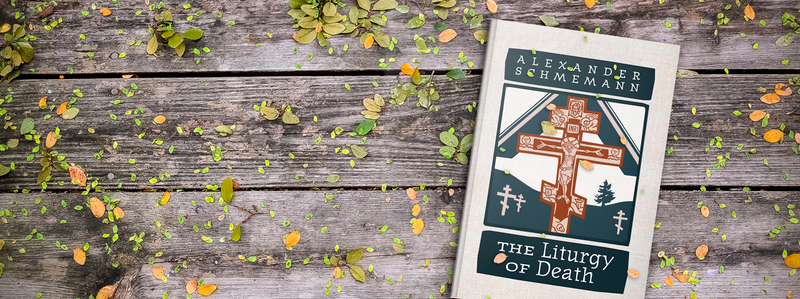Review: The Liturgy of Death
Posted by SVS Press on 26th Aug 2020
The Meaning of Death Ravaged by Secularism and the Church as “Co-Conspirator”
Priest, dean, and historian, Alexander Schmemann was, perhaps, first and foremost a liturgiologist, a critical examiner of the rites and practices of the Orthodox Church. Nowhere is that examination more searing than in The Liturgy of Death, a complete indictment of how the modern Church has got it wrong on the one topic we tend to avoid: death.
The Liturgy of Death, from St Vladimir’s Seminary (SVS) Press, is a collection of talks given by Schmemann at a summer institute in 1979. In it, Schmemann writes that the Church, modern medicine, and the funeral industry have been “co-conspirators” in removing the dead from the living and in “sanitizing” death from being a “meaningful” event, the critical and opportune “decisive hour” of human destiny.
Schmemann begins his talks with a thorough investigation of secularism, that force that is in complete opposition to Christianity and which has stripped death of its Christian meaning.
Here the essential and seemingly paradoxical fact is that our culture ascribes to death no meaning whatsoever. Or, to put it differently, the meaning of death in our modern culture consists in its having no meaning. I will have to explain what I mean, because in reality this is not a paradox at all, but the natural, even inescapable consequence of secularism which, as everyone agrees, is the truly all-embracing sign of our culture . . . Now what is secularism within this context? Whatever else could or should be said about it, secularism is primarily an idea, an experience of life having its meaning and its value in life itself, without any reference to anything that could be termed “otherworldly.”
He then discusses in detail the development of Christian funeral rites and the early Church “where there was a silence about funeral practices and an apparent lack of interest in death or, even more so, in the dead and their survival.” In ancient times, the dead were not separated from the living, as in today’s practice such as when we submit different prayer slips, one for the living and one for the dead. Writes Schmemann: the early Christians believed that “God has created us and brought us ‘into his marvelous light,’ as St Peter says, not for the sake of ‘survival after death’ or even ‘eternal survival in death,’ but for communion with him, for that knowledge of him which alone is life eternal.”
Schmemann expounds in detail today’s burial service and the commemorations of the departed. He points out the “digressions that have permeated the Church’s liturgical life,” and the response of “liturgical rigorists” to “simply perform the prescribed services until people ‘get it,’” writes Alexander Vinogradov in the introduction.
Schmemann reveals the truth of the Gospel throughout the Church’s liturgy of death. In a discussion about the Prayers for the Departed, he points out the uniqueness of the key prayer: “’O God of spirits and of all flesh, who has trampled down death and overthrown the devil and given life unto thy world ‘. . . Its ending constitutes the epkonesis or doxology of the litany: ‘For thou art the resurrection, and the life, and the repose of thy servant, who hath fallen asleep, O Christ our God.’”
Central to Schmemann’s talks is his emphasis on the Eucharist and Pascha as the “two ‘death-centered’ realities in the Church” and “of the key place of Holy Saturday in the pascal ‘three days.’” Indeed, Schmemann shockingly calls for a halt to all burials until Holy Saturday is celebrated in every parish. Writes Vinagradov in the introduction:
Having been baptized “into Christ,” into the one who overcomes death, the dead no longer belong to a separate category. This revolutionary proclamation of the gospel tragically became deformed into what Schmemann calls a return to the “old death,” by which the dead were eventually placed apart and no longer prayed with, but prayed for.”
Schmemann ends his discourse with a discussion of the liturgy of death and contemporary culture.
Our first educational goal, then, is the rediscovery of Christian death as tragedy and sin, an ontological catastrophe, something unnatural about which we will always lament, because God did not create death. Second, we need to rediscover death in its relationship to the victory over death achieved by Christ, which is the theme of the funeral celebration. Finally, we must rediscover death as that stage which consists not of groaning and moaning, but of that mounting light described in the hymn to the Theotokos that speaks of the “dawn of the mystical day.” We are always asleep at the best moment of the day, when nothing yet has appeared, and yet already some light in the East announces hope.
What is fascinating about these talks is to hear Schmemann’s commentary on various topics: how we came to use caskets to bury the dead; why Psalm 50 is so central to Orthodox worship; and why we say “Alleluliah.” Also fascinating is to hear him comment on the consumerism and advertising of 1979, the Iranian Revolution, and Communism. What, can we only wonder, would he have made of the Information Age?




